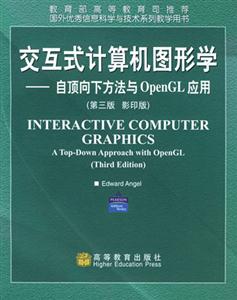-
>
全国计算机等级考试最新真考题库模拟考场及详解·二级MSOffice高级应用
-
>
决战行测5000题(言语理解与表达)
-
>
软件性能测试.分析与调优实践之路
-
>
第一行代码Android
-
>
C Primer Plus 第6版 中文版
-
>
深度学习
-
>
MATLAB计算机视觉与深度学习实战-赠在线交流卡和本书源码
交互式计算机图形学:自预向下方法与OpenGL应用 版权信息
- ISBN:7040137240
- 条形码:9787040137248 ; 978-7-04-013724-8
- 装帧:简裝本
- 册数:暂无
- 重量:暂无
- 所属分类:>>
交互式计算机图形学:自预向下方法与OpenGL应用 内容简介
本书向读者讲授如何用OpenGL从初级阶段快速制作优质的交互式计算机图形实例,OpenGL是业界广泛采用的三维图形API,本书藉此向读者提供了在计算机图形学领域更广阔空间内发展的坚实基础。书中内容覆盖了计算机图形学基础课程所需的所有论题,如光景交互作用、图形明暗处理、图形建模、曲线与曲面、偏差预防、纹理映射和图形组合,还探讨了计算机硬件方面的问题。
本版为配合计算机图形学领域*新进展,增加了更具广度和深度的内容,包括图像处理、多重透视、并行透视等,并运用选择模式、仿真模拟、面向对象图形学与实景图像、射线跟踪等方法讲解了图形交互的内容。随书所附光盘包括OpenGL指令集参考、OpenGL手册、书中源码代码和附加的实用案例。
本书适用于高等院校本科高年级和研究生的计算机图形学、交互式计算机系统等课程。
交互式计算机图形学:自预向下方法与OpenGL应用 目录
Chapter1GraphicsSystemsandModels
1.1ApplicationsofComputerGraphics
1.1.1DisplayofInformation
1.1.2Design
1.1.3SimulationandAnimation
1.1.4UserInterfaces
1.2AGraphicsSystem
1.2.1PixelsandtheFrameBuffer
1.2.2OutputDevices
1.2.3InputDevices
1.3Images:PhysicalandSynthetic
1.3.1ObjectsandViewers
1.3.2LightandImages
1.3.3RayTracing
1.4TheHumanVisualSystem
1.5ThePinholeCamera
1.6TheSynthetic-CameraModel
1.7TheProgrammer'sInterface
1.7.1ApplicationProgrammer'sInterfaces
1.7.2ThePen-PlotterModel
1.7.3Three-DimensionalAPIs
1.7.4ASequenceofImages
1.7.5TheModeling-RenderingParadigm
1.8GraphicsArchitectures
1.8.1DisplayProcessors
1.8.2PipelineArchitectures
1.8.3Transformations
1.8.4Clipping
1.8.5Projection
1.8.6Rasterization
1.8.7PerformanceCharacteristics
1.9SummaryandNotes
1.10SuggestedReadings
Exercises
Chapter2GraphicsProgramming
2.1TheSierpinskiGasket
2.2ProgrammingTwo-DimensionalApplications
2.2.1CoordinateSystems
2.3TheOpenGLAPI
2.3.1GraphicsFunctions
2.3.2TheGraphicsPipelineandStateMachines
2.3.3TheOpenGLInterface
2.4PrimitivesandAttributes
2.4.1PolygonBasics
2.4.2PolygonTypesinOpenGL
2.4.3DrawingaSphere
2.4.4Text
2.4.5CurvedObjects
2.4.6Attributes
2.5Color
2.5.1RGBColor
2.5.2IndexedColor
2.5.3SettingofColorAttributes
2.6Viewing
2.6.1Two-DimensionalViewing
2.6.2TheOrthographicView
2.6.3MatrixModes
2.7ControlFunctions
2.7.1InteractionwiththeWindowSystem
2.7.2AspectRatioandViewports
2.7.3Themain,display,andmyinitFunctions
2.7.4ProgramStructure
2.8TheGasketProgram
2.9PolygonsandRecursion
2.10TheThree-DimensionalGasket
2.10.1UseofThree-DimensionalPoints
2.10.2UseofPolygonsinThreeDimensions
2.10.3Hidden-SurfaceRemoval
2.11SummaryandNotes
2.12SuggestedReadings
Exercises
Chapter3InputandInteraction
3.1Interaction
3.2InputDevices
3.2.1PhysicalInputDevices
3.2.2LogicalDevices
3.2.3MeasureandTrigger
3.2.4InputModes
3.3ClientsandServers
3.4DisplayLists
3.4.1DefinitionandExecutionofDisplayLists
3.4.2TextandDisplayLists
3.4.3FontsinGLUT
3.5ProgrammingEvent-DrivenInput
3.5.1UsingthePointingDevice
3.5.2WindowEvents
3.5.3KeyboardEvents
3.5.4TheDisplayandIdleCallbacks
3.5.5WindowManagement
3.6Menus
3.7Picking
3.7.1PickingandSelectionMode
3.8ASimplePaintProgram
3.9AnimatingInteractivePrograms
3.9.1TheRotatingSquare
3.9.2DoubleBuffering
3.9.3OtherBufferingProblems
3.10DesignofInteractivePrograms
3.10.1Toolkits,Widgets,andtheFrameBuffer
3.11LogicOperations
3.11.1DrawingErasableLines
3.11.2XORandColor
3.11.3CursorsandOverlayPlanes
3.12SummaryandNotes
3.13SuggestedReadings
Exercises
Chapter4GeometricObjectsandTransformations
4.1Scalars,Points,andVectors
4.1.1TheGeometricView
4.1.2Coordinate-FreeGeometry
4.1.3TheMathematicalView:VectorandAffineSpaces
4.1.4TheComputer-ScienceView
4.1.5GeometricADTs
4.1.6Lines
4.1.7AffineSums
4.1.8Convexity
4.1.9DotandCrossProducts
4.1.10Planes
4.2Three-DimensionalPrimitives
4.3CoordinateSystemsandFrames
4.3.1RepresentationsandN-tuples
4.3.2ChangesofCoordinateSystems
4.3.3ExampleofChangeofRepresentation
4.3.4HomogeneousCoordinates
4.3.5ExampleofChangeinFrames
4.3.6WorkingwithRepresentations
4.3.7FramesandADTs
4.3.8FramesinOpenGL
4.4ModelingaColoredCube
4.4.1ModelingofaCube
4.4.2Inward-andOutward-PointingFaces
4.4.3DataStructuresforObjectRepresentation
4.4.4TheColorCube
4.4.5BilinearInterpolation
4.4.6VertexArrays
4.5AffineTransformations
4.6Translation,Rotation,andScaling
4.6.1Translation
4.6.2Rotation
4.6.3Scaling
4.7TransformationsinHomogeneousCoordinates
4.7.1Translation
4.7.2Scaling
4.7.3Rotation
4.7.4Shear
4.8ConcatenationofTransformations
4.8.1RotationAboutaFixedPoint
4.8.2GeneralRotation
4.8.3TheInstanceTransformation
4.8.4RotationAboutanArbitraryAxis
4.9OpenGLTransformationMatrices
4.9.1TheCurrentTransformationMatrix
4.9.2Rotation,Translation,andScaling
4.9.3RotationAboutaFixedPointinOpenGL
4.9.4OrderofTransformations
4.9.5SpinningoftheCube
4.9.6Loading,Pushing,andPoppingMatrices
4.10InterfacestoThree-DimensionalApplications
4.10.1UsingAreasoftheScreen
4.10.2AVirtualTrackball
4.10.3SmoothRotations
4.10.4IncrementalRotation
4.11Quaternions
4.11.1ComplexNumbersandQuaternions
4.11.2QuaternionsandRotation
4.12SummaryandNotes
4.13SuggestedReadings
Exercises
Chapter5Viewing
5.1ClassicalandComputerViewing
5.1.1ClassicalViewing
5.1.2OrthographicProjections
5.1.3AxonometricProjections
5.1.4ObliqueProjections
5.1.5PerspectiveViewing
5.2ViewingwithaComputer
5.3PositioningoftheCamera
5.3.1PositioningoftheCameraFrame
5.3.2TwoViewingAPIs
5.3.3TheLook-AtFunction
5.3.4OtherViewingAPIs
5.4SimpleProjections
5.4.1PerspectiveProjections
5.4.2OrthogonalProjections
5.5ProjectionsinOpenGL
5.5.1PerspectiveinOpenGL
5.5.2ParallelViewinginOpenGL
5.6Hidden-SurfaceRemoval
5.6.1Culling
5.7WalkingThroughaScene
5.8Parallel-ProjectionMatrices
5.8.1ProjectionNormalization
5.8.2Orthogonal-ProjectionMatrices
5.8.3ObliqueProjections
5.9Perspective-ProjectionMatrices
5.9.1PerspectiveNormalization
5.9.2OpenGLPerspectiveTransformations
5.10ProjectionsandShadows
5.11SummaryandNotes
5.12SuggestedReadings
Exercises
Chapter6Shading
6.1LightandMatter
6.2LightSources
6.2.1ColorSources
6.2.2AmbientLight
6.2.3PointSources
6.2.4Spotlights
6.2.5DistantLightSources
6.3ThePhongReflectionModel
6.3.1AmbientReflection
6.3.2DiffuseReflection
6.3.3SpecularReflection
6.4ComputationofVectors
6.4.1NormalVectors
6.4.2AngleofReflection
6.4.3UseoftheHalfwayVector
6.4.4TransmittedLight
6.5PolygonalShading
6.5.1FlatShading
6.5.2InterpolativeandGouraudShading
6.5.3PhongShading
6.6ApproximationofaSpherebyRecursiveSubdivision
6.7LightSourcesinOpenGL
6.8SpecificationofMaterialsinOpenGL
6.9ShadingoftheSphereModel
6.10GlobalRendering
6.11SummaryandNotes
6.12SuggestedReadings
Exercises
Chapter7DiscreteTechniques
7.1Buffers
7.2DigitalImages
7.3WritesintoBuffers
7.3.1WritingModes
7.3.2WriteswithXOR
7.4BitandPixelOperationsinOpenGL
7.4.1OpenGLBuffersandthePixelPipeline
7.4.2Bitmaps
7.4.3RasterFonts
7.4.4PixelsandImages
7.4.5LookupTables
7.4.6BuffersforPicking
7.5MappingMethods
7.6TextureMapping
7.6.1Two-DimensionalTextureMapping
7.6.2TextureMappinginOpenGL
7.6.3TextureObjects
7.6.4Multitexturing
7.6.5TextureGeneration
7.7EnvironmentalMaps
7.8BumpMaps
7.9CompositingTechniques
7.9.1OpacityandBlending
7.9.2ImageCompositing
7.9.3BlendingandCompositinginOpenGL
7.9.4Antialiasing
7.9.5Back-to-FrontandFront-to-BackRendering
7.9.6DepthCueingandFog
7.10MultirenderingandtheAccumulationBuffer
7.10.1SceneAntialiasing
7.10.2BumpMappingandEmbossing
7.10.3ImageProcessing
7.10.4ImagingExtensions
7.10.5OtherMultipassMethods
7.11SamplingandAliasing
7.11.1SamplingTheory
7.11.2Reconstruction
7.11.3Quantization
7.12SummaryandNotes
7.13SuggestedReadings
Exercises
Chapter8ImplementationofaRenderer
8.1BasicImplementationStrategies
8.2FourMajorTasks
8.2.1Modeling
8.2.2GeometricProcessing
8.2.3Rasterization
8.2.4Display
8.3ImplementationofTransformations
8.4Line-SegmentClipping
8.4.1Cohen-SutherlandClipping
8.4.2Liang-BarskyClipping
8.5PolygonClipping
8.6ClippingofOtherPrimitives
8.6.1BoundingBoxesandVolumes
8.6.2Curves,Surfaces,andText
8.6.3ClippingintheFrameBuffer
8.7ClippinginThreeDimensions
8.8Hidden-SurfaceRemoval
8.8.1Object-SpaceandImage-SpaceApproaches
8.8.2SortingandHidden-SurfaceRemoval
8.8.3Back-FaceRemoval
8.8.4Thez-BufferAlgorithm
8.8.5DepthSortandthePainter'sAlgorithm
8.8.6TheScan-LineAlgorithm
8.9ScanConversion
8.10Bresenham'sAlgorithm
8.11ScanConversionofPolygons
8.11.1Inside-OutsideTesting
8.11.2OpenGLandConcavePolygons
8.11.3ScanConversionwiththez-Buffer
8.11.4FillandSort
8.11.5FloodFill
8.11.6Scan-LineAlgorithms
8.11.7Singularities
8.12Antialiasing
8.13DisplayConsiderations
8.13.1ColorSystems
8.13.2TheColorMatrix
8.13.3GammaCorrection
8.13.4DitheringandHalftoning
8.14SummaryandNotes
8.15References
Exercises
Chapter9HierarchicalandObject-OrientedModeling
9.1SymbolsandInstances
9.2HierarchicalModels
9.3ARobotArm
9.4TreesandTraversal
9.4.1AStack-BasedTraversal
9.5UseofTreeDataStructures
9.6Animation
9.7GraphicalObjects
9.7.1Methods,Attributes,andMessages
9.7.2ACubeObject
9.7.3ImplementingtheCubeObject
9.7.4ObjectsandHierarchy
9.7.5GeometricObjects
9.8SceneGraphs
9.9ASimpleSceneGraphAPI
9.9.1TheNodeClass
9.9.2GeometryNodes
9.9.3CameraClass
9.9.4LightsandMaterials
9.9.5Transformations
9.9.6TheRobotFigure
9.9.7ImplementingtheViewer
9.9.8ImplementingaNode
9.10OtherTreeStructures
9.10.1CSGTrees
9.10.2ShadeTrees
9.10.3BSPTrees
9.10.4QuadtreesandOctrees
9.11GraphicsandtheWeb
9.11.1NetworksandProtocols
9.11.2HypermediaandHTML
9.11.3DatabasesandVRML
9.11.4JAVAandApplets
9.12SummaryandNotes
9.13SuggestedReadings
Exercises
Chapter10CurvesandSurfaces
10.1RepresentationofCurvesandSurfaces
10.1.1ExplicitRepresentation
10.1.2ImplicitRepresentations
10.1.3ParametricForm
10.1.4ParametricPolynomialCurves
10.1.5ParametricPolynomialSurfaces
10.2DesignCriteria
10.3ParametricCubicPolynomialCurves
10.4Interpolation
10.4.1BlendingFunctions
10.4.2TheCubicInterpolatingPatch
10.5HermiteCurvesandSurfaces
10.5.1TheHermiteForm
10.5.2GeometricandParametricContinuity
10.6BezierCurvesandSurfaces
10.6.1BezierCurves
10.6.2BezierSurfacePatches
10.7CubicB-Splines
10.7.1TheCubicB-SplineCurve
10.7.2B-SplinesandBasis
10.7.3SplineSurfaces
10.8GeneralB-Splines
10.8.1RecursivelyDefinedB-Splines
10.8.2UniformSplines
10.8.3NonuniformB-Splines
10.8.4NURBS
10.9RenderingofCurvesandSurfaces
10.9.1PolynomialEvaluationMethods
10.9.2RecursiveSubdivisionofBezierPolynomials
10.9.3RenderingofOtherPolynomialCurvesbySubdivision
10.9.4SubdivisionofBezierSurfaces
10.10TheUtahTeapot
10.11AlgebraicSurfaces
10.11.1Quadrics
10.11.2RenderingofSurfacesbyRayCasting
10.11.3SubdivisionCurvesandSurfaces
10.12CurvesandSurfacesinOpenGL
10.12.1BezierCurves
10.12.2BezierSurfaces
10.12.3DisplayingtheTeapot
10.12.4NURBSFunctions
10.12.5Quadrics
10.13SummaryandNotes
10.14ReferencesandNotes
Exercises
Chapter11ProceduralMethods
11.1ReasonsforUsingProceduralModels
11.2PhysicallyBasedModelsandParticleSystems
11.3NewtonianParticles
11.3.1IndependentParticles
11.3.2SpringForces
11.3.3AttractiveandRepulsiveForces
11.4SolvingParticleSystems
11.5Constraints
11.5.1Collisions
11.5.2ParticlesInsideaSphere
11.5.3SoftConstraints
11.6Language-BasedModels
11.7RecursiveMethodsandFractals
11.7.1RulersandLength
11.7.2FractalDimension
11.7.3MidpointDivisionandBrownianMotion
11.7.4FractalMountains
11.8TheMandelbrotSet
11.9SummaryandNotes
11.10SuggestedReadings
Exercises
Chapter12Visualization
12.1Data Geometry
12.2HeightFieldsandContours
12.2.1Meshes
12.2.2ContourPlots
12.2.3MarchingSquares
12.3VisualizingSurfacesandScalarFields
12.3.1VolumetricDataSets
12.3.2VisualizationofImplicitFunctions
12.4IsosurfacesandMarchingCubes
12.5MeshSimplification
12.6DirectVolumeRendering
12.6.1AssignmentofColorandOpacity
12.6.2Splatting
12.6.3VolumeRayTracing
12.6.4TextureMappingofVolumes
12.7Vector-FieldVisualization
12.7.1Hedgehogs
12.7.2Glyphs
12.7.3Color
12.7.4ParticleTracesandStreamlines
12.8TensorVisualization
12.9SummaryandNotes
12.10SuggestedReadings
Exercises
Chapter13AdvancedRendering
13.1GoingBeyondPipelineRendering
13.2RayTracing
13.3BuildingaSimpleRayTracer
13.3.1RecursiveRayTracing
13.3.2CalculatingIntersections
13.3.3Ray-TracingVariations
13.4TheRenderingEquation
13.5Radiosity
13.5.1TheRadiosityEquation
13.5.2SolvingtheRadiosityEquation
13.5.3ComputingFormFactors
13.5.4CarryingOutRadiosity
13.6Renderman
13.7Large-ScaleRendering
13.7.1Sort-MiddleRendering
13.7.2Sort-LastRendering
13.7.3Sort-FirstRendering
13.8Image-BasedRendering
13.8.1ASimpleExample
13.9SummaryandNotes
13.10SuggestedReadings
Exercises
AppendixASamplePrograms
AppendixBSpaces
AppendixCMatrices
References
FunctionIndex
SubjectIndex
交互式计算机图形学:自预向下方法与OpenGL应用 作者简介
EdwardAngeliscurrentlyaprofessorofCommputerSicience,ElectricalandComputerEngineeringandMediaArtsattheuniversityofnewmexico.HewasrecentlynamedtheDirectoroftheArttechCenteratUNMintheCollegeofFineArts.ProfessorAngelreceivedhisPh.D.inelectricalengineeringfromtheuniversityofSouthernCaliforniain1968andhassinceheldvisitingpositionsinSweden,India,andEngland.hispresentresearchinterestsfocusoncomputergraphicsandscientificvisualization.
- >
企鹅口袋书系列·伟大的思想20:论自然选择(英汉双语)
企鹅口袋书系列·伟大的思想20:论自然选择(英汉双语)
¥6.3¥14.0 - >
【精装绘本】画给孩子的中国神话
【精装绘本】画给孩子的中国神话
¥17.6¥55.0 - >
中国人在乌苏里边疆区:历史与人类学概述
中国人在乌苏里边疆区:历史与人类学概述
¥24.0¥48.0 - >
巴金-再思录
巴金-再思录
¥33.1¥46.0 - >
随园食单
随园食单
¥20.6¥48.0 - >
我与地坛
我与地坛
¥16.8¥28.0 - >
月亮与六便士
月亮与六便士
¥13.4¥42.0 - >
有舍有得是人生
有舍有得是人生
¥19.4¥45.0
-
2022图书×抽奖盲袋
¥9.9¥25 -
2023读书月阅读盲盒——天黑,闭眼,刀谁?
¥42.3¥158 -
2022读者节纪念徽章-三星会员专属
¥45¥45.6 -
2023读书月阅读盲盒——我什么场面没见过?
¥42.3¥158 -
2023读书月阅读盲盒——去码头整点什么薯条?
¥42.3¥158















